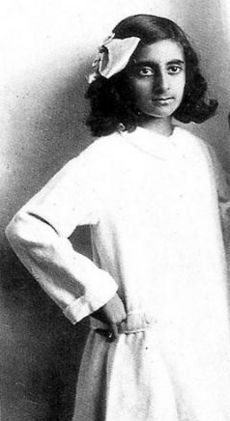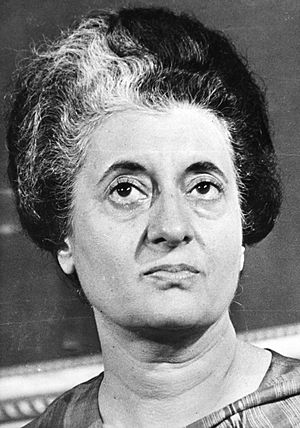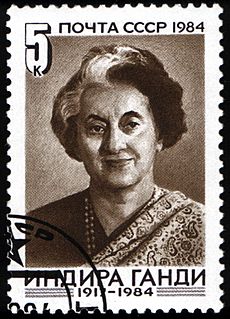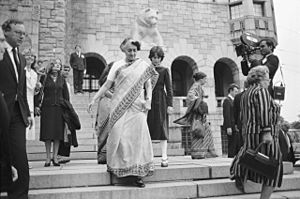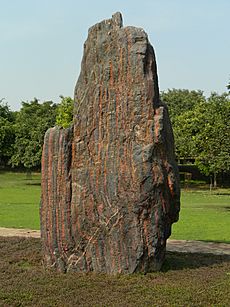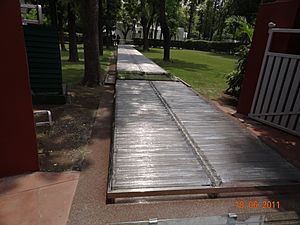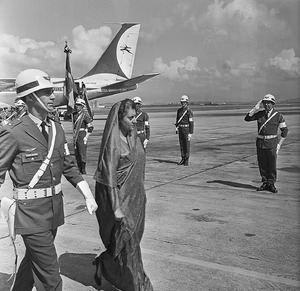Indira Gandhi facts for kids
Quick facts for kids
Indira Gandhi
|
|
|---|---|
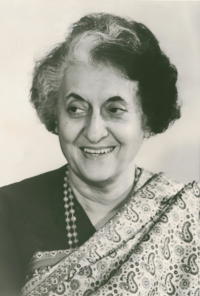
Gandhi in 1983
|
|
| 3rd Prime Minister of India | |
| In office 14 January 1980 – 31 October 1984 |
|
| President | N. Sanjiva Reddy Zail Singh |
| Preceded by | Charan Singh |
| Succeeded by | Rajiv Gandhi |
| In office 24 January 1966 – 24 March 1977 |
|
| President | Sarvepalli Radhakrishnan Zakir Husain V. V. Giri Fakhruddin Ali Ahmed B. D. Jatti (Acting) |
| Deputy | Morarji Desai (13 March 1967 – 16 July 1969) |
| Preceded by | Lal Bahadur Shastri |
| Succeeded by | Morarji Desai |
| Minister of External Affairs | |
| In office 9 March 1984 – 31 October 1984 |
|
| Preceded by | P. V. Narasimha Rao |
| Succeeded by | Rajiv Gandhi |
| In office 22 August 1967 – 14 March 1969 |
|
| Preceded by | M. C. Chagla |
| Succeeded by | Dinesh Singh |
| Minister of Defence | |
| In office 14 January 1980 – 15 January 1982 |
|
| Preceded by | Chidambaram Subramaniam |
| Succeeded by | R. Venkataraman |
| In office 30 November 1975 – 20 December 1975 |
|
| Preceded by | Swaran Singh |
| Succeeded by | Bansi Lal |
| Minister of Home Affairs | |
| In office 27 June 1970 – 4 February 1973 |
|
| Preceded by | Yashwantrao Chavan |
| Succeeded by | Uma Shankar Dikshit |
| Minister of Finance | |
| In office 17 July 1969 – 27 June 1970 |
|
| Preceded by | Morarji Desai |
| Succeeded by | Yashwantrao Chavan |
| Minister of Information and Broadcasting | |
| In office 9 June 1964 – 24 January 1966 |
|
| Prime Minister | Lal Bahadur Shastri |
| Preceded by | Satya Narayan Sinha |
| Succeeded by | Kodardas Kalidas Shah |
| President of the Indian National Congress | |
| In office 1959 |
|
| Preceded by | U. N. Dhebar |
| Succeeded by | Neelam Sanjiva Reddy |
| In office 1978-1984 |
|
| Preceded by | Devakanta Barua |
| Succeeded by | Rajiv Gandhi |
| Personal details | |
| Born |
Indira Priyadarshini Nehru
19 November 1917 Allahabad, United Provinces of Agra and Oudh, British India (present-day Prayagraj, Uttar Pradesh, India) |
| Died | 31 October 1984 (aged 66) New Delhi, India |
| Cause of death | Assassination |
|
Monuments
|
Shakti sthal
|
| Political party | Indian National Congress |
| Spouse | |
| Children | Rajiv Gandhi Sanjay Gandhi |
| Parents | Jawaharlal Nehru (father) Kamala Nehru (mother) |
| Relatives | See Nehru–Gandhi family |
| Education | Visva-Bharati University (dropped out) Somerville College, Oxford (dropped out) |
| Awards |
|
| Signature | |
| Nicknames | see article |
Indira Priyadarshini Gandhi (born Nehru; 19 November 1917 – 31 October 1984) was an important Indian politician. She served as the third prime minister of India for two terms: from 1966 to 1977, and again from 1980 until her death in 1984. She was India's first and only female prime minister.
Indira Gandhi was a key figure in the Indian National Congress party. She was the daughter of Jawaharlal Nehru, who was India's first prime minister. Her son, Rajiv Gandhi, also became prime minister after her. Indira Gandhi was prime minister for a total of 15 years and 350 days, making her the second-longest serving prime minister of India, after her father.
During her father's time as prime minister (1947-1964), Indira often acted as his hostess and traveled with him. In 1959, she became the President of the Indian National Congress. In 1964, after her father passed away, she was appointed as the Minister of Information and Broadcasting. When Prime Minister Lal Bahadur Shastri died suddenly in 1966, Indira Gandhi was chosen to lead the Congress Party. This made her the new prime minister.
As prime minister, Indira Gandhi was known for her strong leadership. In 1967, India successfully defended itself in a border conflict with China. In 1971, she led India into a war with Pakistan to support the independence of East Pakistan, which then became Bangladesh. This victory made India a very powerful country in South Asia.
From 1975 to 1977, Gandhi declared a state of emergency in India. During this time, some basic freedoms were limited, and the press was controlled. Later, she faced a growing movement for a separate Sikh state. In response, she ordered Operation Blue Star, a military action at the Golden Temple. This led to many deaths. On 31 October 1984, Indira Gandhi was assassinated by her own bodyguards.
In 1999, the BBC named her "Woman of the Millennium" in an online poll. In 2020, Time magazine included her among the world's 100 most powerful women of the last century.
Contents
Early Life and Political Start
Indira Gandhi was born Indira Nehru on 19 November 1917, in Allahabad, India. Her family was part of the Kashmiri Pandit community. Her father, Jawaharlal Nehru, was a very important leader in India's fight for independence from British rule. He later became India's first prime minister.
Indira was an only child. She grew up with her mother, Kamala Nehru, at their family home called Anand Bhavan. Her childhood was often lonely because her father was frequently away for political work or in jail. Her mother was often sick and passed away when Indira was young.
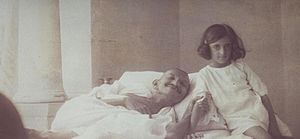
Indira was mostly taught at home by tutors. She also attended several schools, including the Modern School in Delhi and Christian convent schools in Allahabad. She later studied at Visva-Bharati University in Santiniketan. It was there that the famous poet Rabindranath Tagore gave her the name Priyadarshini, meaning "looking at everything with kindness."
After her mother became very ill, Indira went to Europe to care for her. She later planned to study at the University of Oxford in England. She studied history, political science, and economics there. However, her studies were often interrupted by her own health problems. She returned to India in 1941 without finishing her degree at Oxford.
While in Europe, Indira often met Feroze Gandhi (no relation to Mahatma Gandhi), whom she knew from Allahabad. They married in 1942. They had two sons, Rajiv Gandhi (born 1944) and Sanjay Gandhi (born 1946).
In the 1950s, after her marriage, Indira Gandhi worked as an unofficial assistant to her father, Prime Minister Jawaharlal Nehru. Towards the end of the 1950s, she became the President of the Indian National Congress party. In this role, she helped remove the Communist government in Kerala in 1959. This was India's first elected Communist government.
After her father's death in 1964, she joined the Rajya Sabha (the upper house of Parliament). She also served as the Minister of Information and Broadcasting in Prime Minister Lal Bahadur Shastri's government. In January 1966, after Shastri's sudden death, the Congress party chose her as their leader, making her the prime minister.
First Term as Prime Minister (1966–1977)
Indira Gandhi's first eleven years as prime minister saw her grow into a very strong leader. She was able to make big decisions, even if it meant disagreements within her own party. By 1977, she was a dominant figure in Indian politics.
Early Challenges and Decisions
When she first became prime minister, some people in the Congress party and the media thought she would be easy to control. They called her a "dumb doll." However, she quickly showed her strength.
Her first big test was the 1967 general elections. The Congress Party won fewer seats because people were unhappy about rising prices, unemployment, and food shortages. Indira Gandhi was elected to the Lok Sabha from the Raebareli area. She made a difficult decision to lower the value of the Indian currency, which caused some problems for businesses and consumers.
In 1969, she had disagreements with senior Congress leaders. One major issue was her decision to support an independent candidate for president, instead of the official party candidate. Another was her decision to nationalize banks without consulting her finance minister. These actions led to her being expelled from the party. However, she formed her own group, called Congress (R), and most Members of Parliament stayed with her. Her government continued with the support of other regional parties.
India's Growing Strength
Border Conflict with China
In 1967, India had a military conflict with China along the border of Sikkim, which was then protected by India. India successfully pushed back the Chinese attack. This showed India's strength in the region.
Indira Gandhi stated that China continued to be unfriendly towards India. In 1975, she brought Sikkim fully into India after a vote by the people there. China strongly criticized this move.
"Remove Poverty" Campaign
For the 1971 elections, Indira Gandhi used the powerful slogan "Garibi Hatao" (Remove Poverty). This slogan was a response to her opponents' slogan, "Indira Hatao" (Remove Indira). The "Garibi Hatao" campaign promised to help the poor in both rural and urban areas. It aimed to give them more political power and support. The programs under this campaign were designed and funded by the central government.
War for Bangladesh's Independence
Indira Gandhi's greatest achievement after the 1971 election was India's victory over Pakistan in December 1971. This war, which was part of the Bangladesh Liberation War, led to the creation of independent Bangladesh. This victory greatly increased India's influence and made it the leading power in South Asia. After the war, she was highly praised.
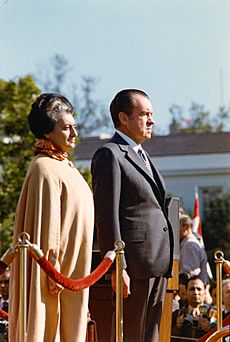
Election Dispute and Emergency Rule
On 12 June 1975, a court ruled that Indira Gandhi's election to Parliament in 1971 was invalid due to some election rule violations. The court said she used government resources for her campaign. The court ordered her to lose her parliamentary seat and banned her from holding office for six years. This meant she could no longer be prime minister.
However, Indira Gandhi refused to resign. She announced she would appeal the decision to the Supreme Court. She insisted that the ruling did not weaken her position and that her party supported her.
The State of Emergency (1975–1977)
To deal with the unrest and challenges after the court decision, Indira Gandhi ordered the arrest of many opposition leaders. Her government then advised the President to declare a state of emergency. This was done on 25 June 1975, due to internal disorder.
During the Emergency, police were given powers to arrest people without trial, and all news publications were censored. Elections were postponed, and opposition-led state governments were removed. The President issued special orders that did not need Parliament's approval, allowing Gandhi to rule by decree.
During this period, Indira Gandhi's younger son, Sanjay Gandhi, became very influential, even though he held no official government position. He was said to have a lot of power and influence over government decisions.
1977 Election and Return to Power
In 1977, after extending the Emergency twice, Indira Gandhi called for new elections. She might have misjudged how popular she was, as the news she received was heavily censored. She was opposed by the Janata Party, an alliance of opposition parties. The Janata alliance argued that these elections were India's last chance to choose between "democracy and dictatorship."
Indira Gandhi's Congress party suffered a major defeat in these elections. Both she and her son, Sanjay Gandhi, lost their seats in Parliament. The Janata alliance, led by Morarji Desai, came to power after the Emergency was lifted.
In Opposition and Back to Power
Since Indira Gandhi lost her seat, the Congress party appointed a new leader. Soon after, the Congress party split again, and Gandhi formed her own group. She won a special election in November 1978 and returned to Parliament.
The Janata government's home minister, Charan Singh, ordered her arrest on several charges. This move, however, backfired. Her arrest and the long trial gained her sympathy from many people. The Janata government itself was struggling with internal disagreements. In 1979, the government fell apart.
Charan Singh became prime minister for a short time, but his government also failed. President Reddy then dissolved Parliament and called for new elections in 1980. Before these elections, Indira Gandhi sought support from various communities. In the elections held in January 1980, the Congress party, under Indira Gandhi, returned to power with a huge victory.
Fourth Term (1980–1984)
Indira Gandhi's Congress Party won a landslide victory in January 1980. She was elected to Parliament from the Medak area. Sadly, on 23 June 1980, her younger son, Sanjay Gandhi, died in a plane crash in New Delhi.
After Sanjay's death, Indira Gandhi relied mostly on her family members. She convinced her older son, Rajiv Gandhi, who was a pilot, to enter politics in February 1981. Rajiv later became prime minister after his mother's death.
Operation Blue Star
During her second term, Indira Gandhi faced a growing movement for a separate Sikh state in the state of Punjab. To address this, her Congress Party initially supported a religious leader named Jarnail Singh Bhindranwale. However, Bhindranwale's group became involved in violence, and he was accused of encouraging murder.
Bhindranwale then distanced himself from the Congress Party. By 1983, he and his armed followers had fortified parts of the Golden Temple complex, a very holy site for Sikhs. The temple became a stronghold for militants.
After many failed talks, in June 1984, Indira Gandhi ordered the Indian army to enter the Golden Temple. This military action, called Operation Blue Star, aimed to remove Bhindranwale and his supporters. The army used heavy artillery, including tanks, which caused significant damage to parts of the Temple complex, including the Akal Takht shrine and the Sikh library. Many Sikh fighters and innocent pilgrims were killed. The exact number of casualties is still debated.
This action was heavily criticized by Sikhs in India and around the world. Some Sikh soldiers even mutinied after the attack.
Assassination
On 31 October 1984, Indira Gandhi was assassinated by two of her Sikh bodyguards, Satwant Singh and Beant Singh. They shot her with their service weapons in the garden of her official residence in New Delhi. This act was reportedly in revenge for Operation Blue Star.
The shooting happened as she was walking past a gate guarded by the two men. She was on her way to be interviewed by a British filmmaker. The bodyguards dropped their weapons and surrendered. Beant Singh was later shot dead by other guards. Kehar Singh was arrested for being part of the plan. Both Satwant Singh and Kehar Singh were sentenced to death and executed.
Indira Gandhi was taken to the hospital but was declared dead at 2:20 PM. Her death was announced on television hours later.
She was cremated on 3 November according to Hindu traditions. The place where she was cremated is now known as Shakti Sthal. Her funeral was shown live on television around the world.
Her assassination had a huge impact on Indian politics. Her son, Rajiv Gandhi, became prime minister just hours after her death. Sadly, anti-Sikh riots broke out in several cities, leading to the deaths of thousands of Sikhs.
International Reaction
Indira Gandhi's death was mourned by leaders worldwide. Many expressed sadness and said her death would leave a "big emptiness" in global affairs. Leaders from the Soviet Union, the United States, and many other countries sent their condolences and condemned the assassination. The United Nations General Assembly paused its work to honor her memory.
Foreign Relations
Indira Gandhi was known for her strong foreign policy. She effectively promoted India's interests on the world stage.
Relations with Neighboring Countries
In early 1971, a dispute in Pakistan led to East Pakistan declaring independence as Bangladesh. The Pakistani army's actions caused 10 million refugees to flee into India. In December 1971, Gandhi decided to intervene directly in the conflict to help Bangladesh gain independence. India's victory in this war made it the dominant power in South Asia.
India had signed a treaty with the Soviet Union for mutual support in case of war. Meanwhile, Pakistan received support from the United States. U.S. President Richard Nixon did not like Gandhi personally. After the war, relations with the U.S. became distant, and Gandhi developed closer ties with the Soviet Union. The Soviet Union became India's largest trading partner and main arms supplier.
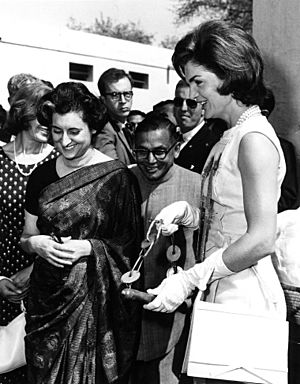
India maintained close ties with Bangladesh after its independence. However, relations became strained when military governments took over in Bangladesh. Despite this, Bangladesh later honored Gandhi for her "outstanding contribution" to their country's independence.
Gandhi's approach to Sri Lanka's ethnic problems was initially friendly. However, relations worsened when Sri Lanka moved away from socialist policies. India was said to have supported Tamil militants in Sri Lanka to pressure its government. Still, Gandhi stated that India supported Sri Lanka's unity but could not ignore injustice to the Tamil community.
India's relationship with Pakistan remained difficult after the 1971 war. Gandhi's decision to test a nuclear device in 1974 was seen by Pakistan as an attempt to intimidate them. This led Pakistan to pursue its own nuclear program. Relations hit a low point when General Muhammad Zia-ul-Haq came to power in Pakistan. Gandhi accused him of supporting Sikh militants in Punjab.
To keep the Soviet Union and the United States out of South Asia, Gandhi helped establish the SAARC in 1983.
Middle East and Asia-Pacific
Gandhi strongly supported the Palestinians in the Arab–Israeli conflict and criticized U.S. diplomacy in the Middle East. India viewed Israel as a religious state, similar to its rival Pakistan. Despite this, Gandhi secretly allowed contact and security help with Israel in the late 1960s.
India's pro-Arab policy had mixed results. While it helped counter Pakistani propaganda, the 1971 war created a dilemma for Arab and Muslim states. Some Arab countries remained neutral, while others openly supported Pakistan.
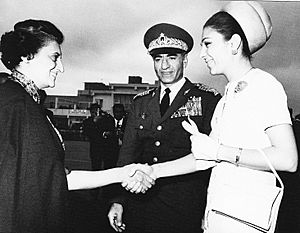
Relations with Iran improved during the 1970s. India and Iran increased their economic and military cooperation. Iran supplied a large portion of India's crude oil needs.
In Southeast Asia, the formation of ASEAN in 1967 initially led to strained relations with India. ASEAN saw India as too close to the Soviet Union. Relations began to improve after the Vietnam War and the end of the SEATO alliance. However, Gandhi's close ties with Vietnam and her recognition of the Cambodian government in 1980 prevented a strong partnership between India and ASEAN.
Africa and Commonwealth
India, under Indira Gandhi, worked to improve its image in Africa. She openly supported liberation movements in Africa, unlike earlier Indian leaders. This helped India regain its anti-imperialist image and strengthen its presence in Africa.
India maintained good relations with most members of the Commonwealth of Nations. Gandhi was seen as a key figure in the Commonwealth. India hosted the 1983 Commonwealth summit in New Delhi. Gandhi used these meetings to pressure member countries to cut ties with Apartheid South Africa.
Non-Aligned Movement
In the early 1980s, India tried to regain its leading role in the Non-Aligned Movement. This movement consisted of countries that did not align with either the U.S. or the Soviet Union during the Cold War. Gandhi focused on linking disarmament with economic development for developing countries. While hosting the 1983 summit boosted India's standing, its close ties with the Soviet Union limited its influence on some Cold War issues.
Soviet Union and Western Europe
India's relationship with the Soviet Union grew stronger under Gandhi. The Soviet Union provided arms and supported India in the 1971 war. Before the war, Gandhi signed a friendship treaty with the Soviets. They became India's main arms supplier and largest trading partner by the early 1980s.
Gandhi also had good relationships with leaders in Western Europe, including the West German chancellor and British prime ministers.
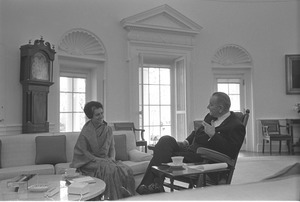
When Gandhi became prime minister in 1966, India relied on the U.S. for food aid. Gandhi disliked the U.S. using food aid to influence India's policies. Relations with the U.S. were especially strained under President Richard Nixon, who favored Pakistan during the Bangladesh war. However, in the 1980s, Gandhi developed a good working relationship with U.S. President Ronald Reagan.
Economic Policies
Indira Gandhi oversaw three Five-Year Plans as prime minister. These plans aimed to guide India's economic development.
There is debate about whether Gandhi was truly a socialist or if she used socialist ideas for political reasons. Some critics said her socialism was "more posture than policy." However, others believed she genuinely cared for the poor. Her famous slogan, "Garibi Hatao" (Remove Poverty), became a key motto for the Congress Party.
Green Revolution and Economic Growth
When Gandhi became prime minister, India's economy was struggling due to a war and a severe drought that caused food shortages. Her government responded by trying to open up the economy and devaluing the currency. However, foreign aid promised by the U.S. did not fully arrive, partly due to political disagreements. This made India wary of relying on foreign aid.
To solve India's food problems, Gandhi continued and expanded efforts to boost agricultural production. This led to the Green Revolution in India in the 1970s. India transformed from a country that relied on imported grains to one that could largely feed itself. Gandhi personally wanted India to be self-sufficient in food, as she found India's dependence on the U.S. humiliating.
From 1967 to 1975, India saw a rise in socialist policies. Gandhi expanded the public sector, meaning more industries were controlled by the government. She also introduced new rules for private industries.
The Fifth Five-Year Plan (1974–79) was launched during the state of emergency. Gandhi promised to reduce poverty and bring about social and economic reforms. The economy grew well during this period, exceeding its targets.
Economic Reforms in the 1980s
When Gandhi returned to power in 1980, the economy was weak, with high inflation. She launched the Sixth Five-Year Plan (1980–85) and aimed for an average growth rate of 5.2%. Measures were taken to control inflation, which came down significantly.
Although she still spoke of socialist beliefs, the Sixth Plan was more practical. It focused on controlling government spending, making state-owned businesses more efficient, and encouraging the private sector through fewer regulations. This plan became the most successful of the Five-Year Plans so far, with an average growth rate of 5.7%.
Inflation and Jobs
Inflation, which is the rate at which prices increase, was a challenge in the 1970s, partly due to the international oil crisis. Gandhi introduced strict measures to control it during the Emergency, and inflation even became negative for a short time.
When she returned to power in 1980, inflation was high again. However, her government managed to bring it down to about 5% by the early 1980s. The unemployment rate remained steady for many years before slightly decreasing in 1983.
Domestic Policies
Nationalization of Industries
Before Indira Gandhi, most banks in India were privately owned. People often accused bank owners of using deposits for their own companies instead of helping the poor. Gandhi wanted to nationalize banks to help reduce poverty. In 1969, she took over fourteen major commercial banks. This led to a huge increase in bank deposits and branches, especially in rural areas. It also helped small businesses and agriculture.
After her re-election in 1971, Gandhi continued to nationalize other industries, including coal, steel, and oil companies. This was often done to protect jobs and the interests of workers. For example, she nationalized some oil companies in 1973 because foreign-owned companies refused to supply fuel to the Indian military during the 1971 war.
Administrative Changes
In 1966, Gandhi agreed to divide Punjab into new states based on language. The Hindi-speaking part became Haryana, and the hilly areas joined Himachal Pradesh. However, the city of Chandigarh remained a shared capital for both Punjab and Haryana.
After India's victory in the 1971 war, India's power in Kashmir grew stronger. The main Kashmiri separatist leader, Sheikh Abdullah, agreed to recognize India's control over Kashmir in exchange for a special autonomous status. In 1975, Gandhi declared Jammu and Kashmir a part of India.
In 1972, Gandhi also granted statehood to Meghalaya, Manipur, and Tripura. She also renamed the North-East Frontier Agency to Arunachal Pradesh and made it a union territory. In 1975, Sikkim was officially annexed into India.
Social Reforms
Under Indira Gandhi's government, the Indian Constitution included the principle of equal pay for equal work for both men and women.
Gandhi also worked to abolish the "privy purse," which was a payment given to former rulers of princely states. She argued that all citizens should have equal rights and that these payments were a drain on government money. After some legal challenges, the privy purse was successfully abolished in 1971 through a constitutional amendment.
During the state of emergency in 1975, Gandhi launched a large program to redistribute land and provide housing for landless workers. She also abolished bonded labor and helped reduce the debts of the poor. These reforms aimed to help the most vulnerable sections of society.
Language and Security Policies
The Indian Constitution stated that Hindi would become the official national language by 1965. However, many non-Hindi speaking states wanted English to continue being used. In 1967, Gandhi introduced a change to the Constitution that allowed both Hindi and English to be official languages. This policy of bilingualism satisfied non-Hindi speaking states and showed her vision for a united India.
In the late 1960s and 1970s, Gandhi's government used the Indian army to suppress Communist uprisings in West Bengal. During the state of emergency, these insurgencies were largely put down.
Gandhi considered India's northeastern region very important due to its location. In 1966, a rebellion broke out in Mizoram. Gandhi ordered the Indian Air Force to carry out airstrikes in Aizawl, which is the only time India has used airstrikes within its own territory. After the defeat of Pakistan in 1971, the Mizo separatist movement weakened. In 1972, Mizoram was made a union territory.
Similarly, Gandhi launched a strong military offensive against insurgents in Nagaland in the 1970s. In 1975, the insurgents agreed to surrender and signed the Shillong Accord, ending large-scale conflicts.
India's Nuclear Program
Indira Gandhi continued the vision of her father, Jawaharlal Nehru, to develop India's nuclear program. In 1967, she authorized the development of nuclear weapons after China conducted its own nuclear test. Gandhi saw this as a threat and wanted India to have its own nuclear capability for security.
In 1974, India successfully conducted an underground nuclear test, code-named "Smiling Buddha," in Rajasthan. This made India a nuclear power. Pakistan's prime minister, Zulfikar Ali Bhutto, strongly protested, seeing it as an attempt to intimidate Pakistan. He then launched a major effort to make Pakistan a nuclear power. Gandhi stated that India's test was for peaceful purposes and for scientific use.
Despite international criticism and a drop in foreign investment, the nuclear test was very popular in India. It boosted Gandhi's popularity and improved the image of the Congress Party.
Personal Life and Views
Indira Gandhi married Feroze Gandhi in 1942. Their marriage lasted 18 years until he passed away in 1960. They had two sons, Rajiv and Sanjay. After Sanjay's death in 1980, Indira convinced her older son, Rajiv, to enter politics.
Views on Women
Indira Gandhi once said, "I am in no sense a feminist, but I believe in women being able to do everything." This shows her complex feelings about gender. She grew up with male cousins and felt a natural sense of equality. She often said she didn't know the difference between a boy and a girl until she was twelve.
Gandhi did not often talk about her gender, but she was involved in women's issues before becoming prime minister. She helped set up the Congress Party's Women's Section in 1956. She often tried to encourage women to get involved in politics.
As a child, she was fascinated by Joan of Arc, a historical figure who led her people. Indira once told her aunt, "Someday I am going to lead my people to freedom just as Joan of Arc did!"
While she was prime minister, she did not appoint many women to high cabinet positions. However, many women still saw her as a symbol of women's power and a feminist icon. She also felt that motherhood was a very important part of her life.
Legacy
After leading India to victory in the Bangladesh Liberation War in 1971, President V. V. Giri awarded Indira Gandhi with India's highest civilian honor, the Bharat Ratna. In 2011, Bangladesh also honored her posthumously for her contributions to their independence.
Indira Gandhi's main legacy includes her strong stand against American pressure during the Bangladesh war and her decision to make India a nuclear power. Although India was officially non-aligned, she leaned towards the Soviet Union in foreign policy.
In 1999, the BBC named her "Woman of the Millennium." In 2012, she was ranked among "the Greatest Indian" in a poll.
Indira Gandhi left a powerful but sometimes debated legacy in Indian politics. Critics say she weakened internal party democracy and centralized power. She is also associated with the period of Emergency rule, which is seen as a difficult time for Indian democracy. Some also believe she fostered a culture of nepotism (favoring family) in politics.
The Congress party, which was once a broad movement, became more controlled by the Gandhi family during her time. This led to a tradition of family members succeeding each other in power.
She remains the only woman to have served as prime minister of India. In 2020, Time magazine recognized her as one of the world's 100 most powerful women who shaped the last century. Shakti Sthal, meaning "place of strength," is a monument dedicated to her.
Posthumous Honours
- Bangladesh Freedom Honour, Bangladesh's highest civilian honor for non-nationals.
- The southernmost point of India, Indira Point, is named after her.
- The Indira Awaas Yojana, a government housing program for the rural poor, is named after her.
- The international airport in New Delhi is named Indira Gandhi International Airport in her honor.
- The Indira Gandhi National Open University, one of the world's largest universities, is also named after her.
- The Indian National Congress established the annual Indira Gandhi Award for National Integration in 1985, given in her memory.
- The Indira Gandhi Memorial Trust also created the annual Indira Gandhi Prize.
Images for kids
See also
 In Spanish: Indira Gandhi para niños
In Spanish: Indira Gandhi para niños
- Indian National Congress
- List of presidents of the Indian National Congress
- List of assassinated Indian politicians
- List of elected and appointed female heads of state and government
- Category:Indira Gandhi administration


